
17 minute read
French Guyana: Exploring Hidden Jungle Fisheries
After two years of waiting, I finally made the long-awaited expedition we’d been preparing for months with Yann, my childhood friend. In 2019, I came to visit Yann for the first time. He has been living in French Guyana for a few years now. As soon as he arrived, he told me about the jungle as he saw it: a dense, impenetrable forest with an unwelcoming appearance.
BY FRANCOIS BIETRY

I remember seeing Yann’s vision evolve over the months and years he was there. I was discovering this country through his words, and the more time that passed, the more welcoming this forest seemed - if you approached it the right way. He would send me photos of spiders of all sizes, snakes of all colors, and incredible rivers. What at first appeared to be a green hell became an insider’s delight for those who liked bugs and humidity. Shortly afterward, he talked to me about the fishing.
Yann has always been a talented fly fisher and competitor. Minimes, Cadets and Juniors at the French Youth Championships, he has twice won the title of French Champion, and has landed in the jungle with the technical experience of a French competitor. Educated as a nymph on “A la roulette” (classic French nymphing technique).

Hoplias Animara
He tells me that a mysterious fish lives in the black waters of Guyana’s rivers, a nocturnal carnivore with Pitbull snags and special forces armor. Hoplias Aimara.
But how do you catch this beast on the fly? Little information is available on the Internet, and the fish distribution is quite uneven depending on the river or creek where it lives.
The solution is to spend hours and hours on the water looking for it and trying to understand it.
After several years of living on the banks of the river marking the border with Brazil, Yann’s understanding of the behavior of this fish—thriving in waters that fluctuate between 100 and 140,000 ft³/s between the dry and rainy seasons—has become increasingly refined.

In November 2019, I finally flew to Cayenne with two 9-weight rods and a handful of big streamers. This long-awaited first trip was a mesmerizing introduction to the Amazon Rainforest alongside my friend, who had become an expert in bugs and knew his river like the back of his hand. I was fortunate enough to hook a few of his prized Aimaras on the fly, but my equipment was woefully inadequate against these black devils. The moment they took the fly, they had only one goal: to retreat into the depths, weaving through the sharp granite boulders where they dwell.
Fast forward to December 2023. This time, with a much clearer idea of what awaited me in the jungle, I set off armed with a 7’9” 12-weight fiberglass rod—painstakingly built on a Rodhouse blank by my friend Laurent Keiff. A philosopher, rod-builder, madman of a caster, and an incurable blank geek, Laurent and I had a long discussion about my needs, the brutal fishing conditions, and the sheer force the rod would endure. Then, with a knowing grin, he told me about this atypical rod:
“So,” he said, “it has the diameter of a supermarket neon light, could lift a donkey without breaking a sweat, and the Spanish guys are landing 2-meter catfish with it.” Perfect!
Between sips of Cuban rum at the legendary Black Sonata bar in Argentat-sur-Dordogne, I placed my order: a heavy-duty reel, an intermediate line tough enough for GTs, and a batch of monstrous streamers. Then, once again, I was off to Cayenne.
This time, Yann and I embarked on a 12-day self-sufficient expedition aboard a fiberglass Mouchalagan—a traditional Canadian canoe. Our plan: paddle across the largest lake in French territories, then push several kilometers upstream into the river.

Taking no chances, I carefully replaced the loop on my fly line with a several-centimeter-long homemade ligature—advice from a friend who likes to pull very hard when he’s hooked into a GT.
A 130-pound test fluorocarbon leader, 80-pound steel cable, a rolling snap, and finally—the masterpiece: a Magic Carpetstreamer, as big as a giant’s hand, mounted on a 10/0 hook and armed with a gleaming willow leaf spinner nestled among its flashy fibers. The sharp pop of a Saint-Émilion Grand Cru cork echoed through the jungle, marking our arrival. The cooler still guarded the last fresh meal of our journey: duck breast with pommes de terre sarladaises, sizzling over the fire—a well-earned comfort for our soaked and weary souls.

At the crack of dawn, barely in bed and already up, rods rigged and streamers sharpened, Yann took the helm of the canoe as we set off toward the lower Saut—the local term for a rapid. Standing at the bow, I launched my streamer with all my strength, aiming for the base of the granite chaos where the river foamed. Just a few casts in, I nearly had the rod ripped from my hands the instant the fly hit the water. Stunned by the sheer violence of the strike, I set the hook too early—missing the first fish of the trip.
After some cursing and a deep breath, we pulled up onto a massive boulder in the middle of the Saut, deciding to weave our way upstream, searching for pockets to slam our streamers into.
Balancing on a half-submerged log, Yann suddenly lost a massive fish… Aimaras can reach up to forty pounds, with the French Guiana record standing at 18 kg. Frustration gave way to renewed focus. I reached a promising spot, braced myself for impact, and fired my streamer between two enormous boulders at point-blank range. Before I could even begin my first strip, the fiberglass rod bent hard— right into the handle.
“Yann!” I called out. “Net! Two meters below!”
After a titanic struggle—jumping from rock to rock—Yann managed to land the first Aimara of the trip.

That’s it! Box ticked.
A feeling every traveling angler knows well: the relief and satisfaction of the first catch. Now came the tricky part. The Aimara’s jagged teeth clamped down on the shredded streamer, making it clear that sticking our fingers in its mouth wasn’t an option. Piercing it with a boga grip?
Out of the question. Instead, much like handling a northern pike, a delicate grip under the gill plate ensured a smooth and injury-free release of this prehistoric beast. After a few quick photos, Hoplias returned to its submerged granite lair.
Over the next four days, we landed a series of magnificent Aimaras in these rapids. Torrential rain, soaked hammocks, and military rations became the rhythm of our days, as we paddled deeper into the wilderness, pushing further with each outing.

A couple of days passed, and life out here felt good. We had become comfortable slaloming through the boulders of our home rapid, but soon, that itch for the unknown returned. With the last sliver of battery on one of our phones, we scoured an offline map for a new challenge. We found one: a remote stretch of water 53 km upstream, past several white-water rapids that we’d have to ascend before making the long paddle back down.
A four-day minimum of hardcore upstream travel. Limited food. High risk. We looked at each other, weighed the odds, and settled on a simple plan: let’s not die this time. Instead, we found another promising spot, much closer. It was time to pack up and prepare for a day trip into the unknown.

It was humid, as always, but strangely, we were getting used to it. Our provisions were running low: a few potatoes, some rice, pasta, peppers, spices, and the last vacuum-sealed piece of chicken, which was beginning to warm up in the heat.
On the morning of the ninth day, after a quick coffee, we set off to explore a tributary that joined our river downstream from camp. A blackwater creek, winding through a labyrinth of submerged dead trees. Massive granite boulders, weighing several tons, fragmented the river, carving out tight meanders.
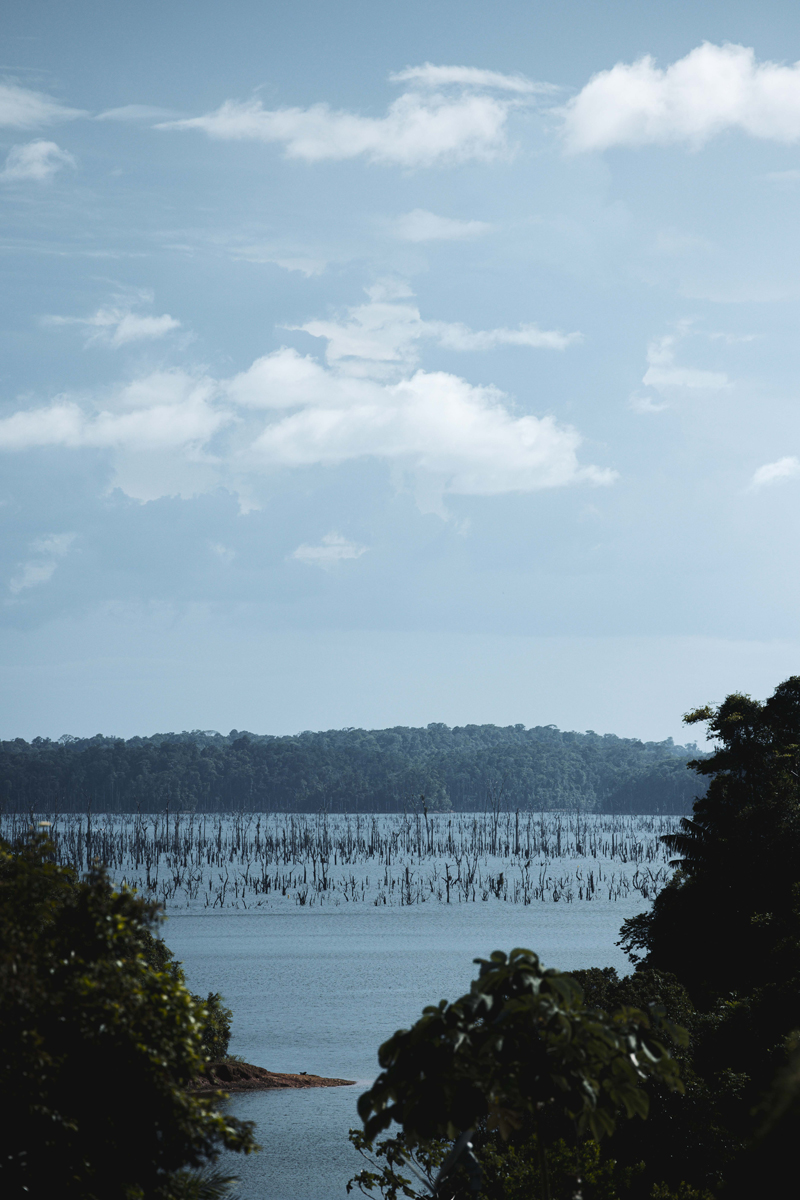
By 4 p.m., with nightfall only two hours away, we were still deep in the unknown, two hours of paddling from camp. But turning back now wasn’t an option—not before seeing the source of the roaring we could hear deep in the forest. The whitewater’s tumult blended with the guttural howls of monkeys and the piercing cries of birds, a deafening, primal symphony.
Navigating upstream became increasingly treacherous. Submerged trees slowed our progress to a crawl. At times, we had to flatten ourselves inside the canoe, squeezing beneath low-hanging branches, praying we wouldn’t snag on an invisible stump and capsize. The decaying logs were thriving nests of biodiversity—tarantulas, toads, snakes, and all manner of arachnids made their homes here. We moved cautiously, watching where we placed our hands as we clung to the drenched trees for support.
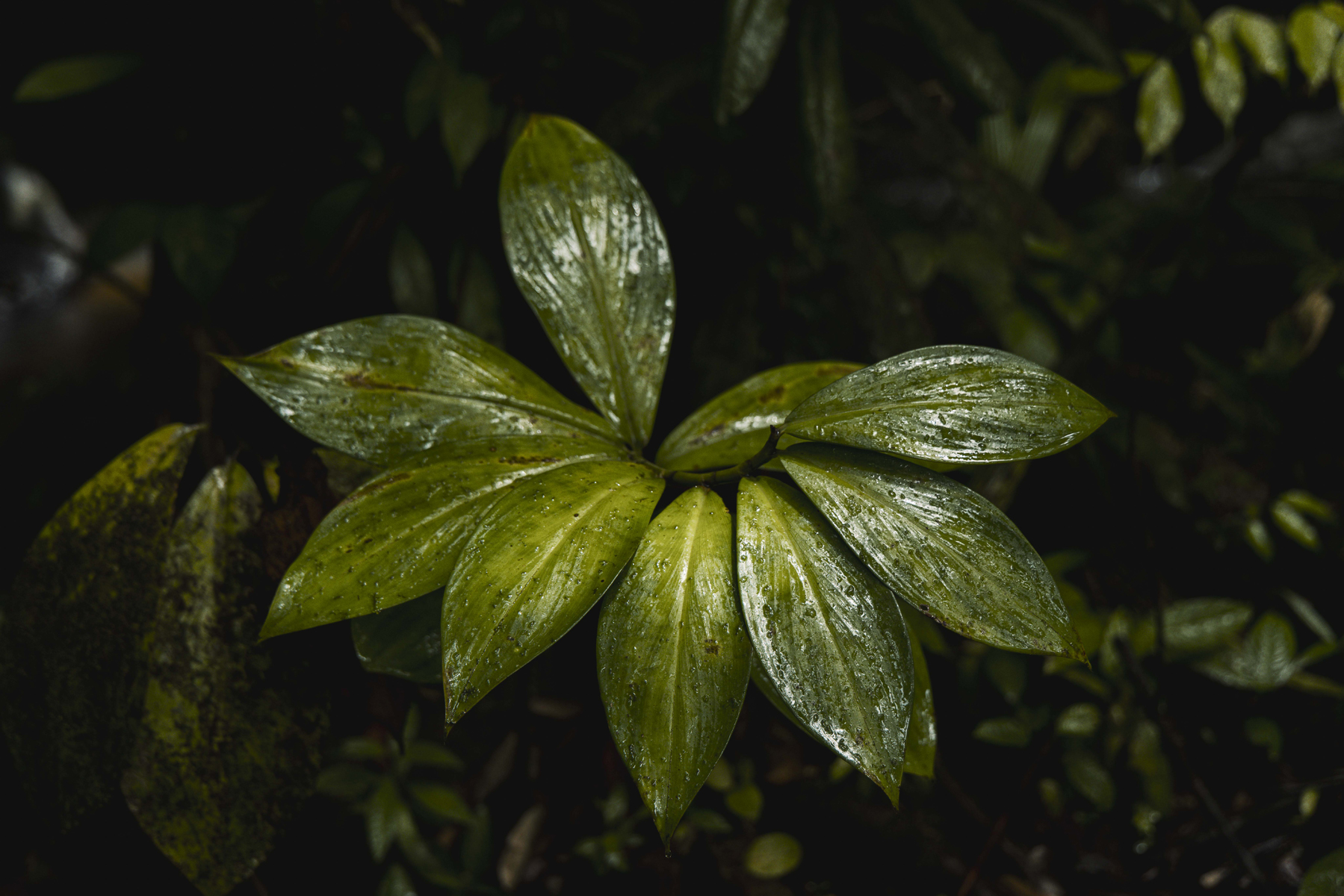
The birdsong faded, drowned by the growing roar of rushing water. The current became too strong to paddle any further. It was time to pull the boat to safety. Waist-deep in water, we dragged the canoe onto a narrow patch of beach, securing it before continuing on foot.
5 p.m. Yann grabbed the ready-togo 12-weight rod and waded ahead toward the next bend. I opened my Peli case, my waterproof fortress for camera gear, eager to capture the thickening fog rolling over the water. “I’m going to check up ahead,” Yann called over his shoulder, already waist-deep and nearly out of sight. “I’ll stay here for some shots!” I replied.
And just like that, I was alone.

Feet sinking into the black earth, camera in hand, I looked up toward the still-white sky. A delicate mist curled off the river’s surface. Time seemed to stretch and dissolve. I lost myself in the eerie beauty of the moment, composing frames—first with the 200mm lens, then switching to macro, and finally wide-angle.
I wandered along the water’s edge, my eyes scanning for movement— frogs, insects, lichens. I hoped to spot a snake, its patterned body weaving through the undergrowth, a perfect subject for my lens.

Time slipped away, impossible to measure. Eventually, I made my way back to the boat, expecting to find Yann waiting. But he wasn’t there. Dusk was settling in. The soft, fading light told me it must be close to 6 p.m.
I called out, “YANN!” My voice echoed through the trees. Silence. I whistled once. Then again. Nothing. I knew the man well. But caution was key. I took a moment to prepare. I packed my bag—headlamp, satellite phone, camera, water, snacks, machete, first-aid kit. Then, I settled into the boat, feet stretched out, opening a book. And waited.
I say to myself: 5 pages, and if he doesn’t show up with the happy face of having discovered a new piece of water, I go up to look for him along the river.

A moment later, I realize I can barely see anymore—damn, the book was too good. I must’ve read at least twenty pages. Snapping back to reality, I stash the book inside the Peli case, tucking it under a pile of leaves. I pull the boat further onto the shore, securing it properly. Then, I switch on my headlamp, grip my machete, and step cautiously into the forest, following the river’s edge.
“YANN!” Nothing. The roar of the rapids grows louder as I push into the undergrowth, where the jungle has already swallowed the last traces of daylight. The only illumination comes from my headlamp bouncing off slick leaves, reflecting the ghostly white foam of the churning water below. I hope he didn’t fall in.
I hack my way through vines and dense-leaved shrubs, fighting the resistance of the jungle, when suddenly—I stumble onto a well-marked trail. Odd.
A few hundred meters in, I come across what looks like an abandoned campsite. Torn tarps hang limply between roughly cut trees, revealing the remains of a makeshift shelter. I freeze. Listening. Silence.
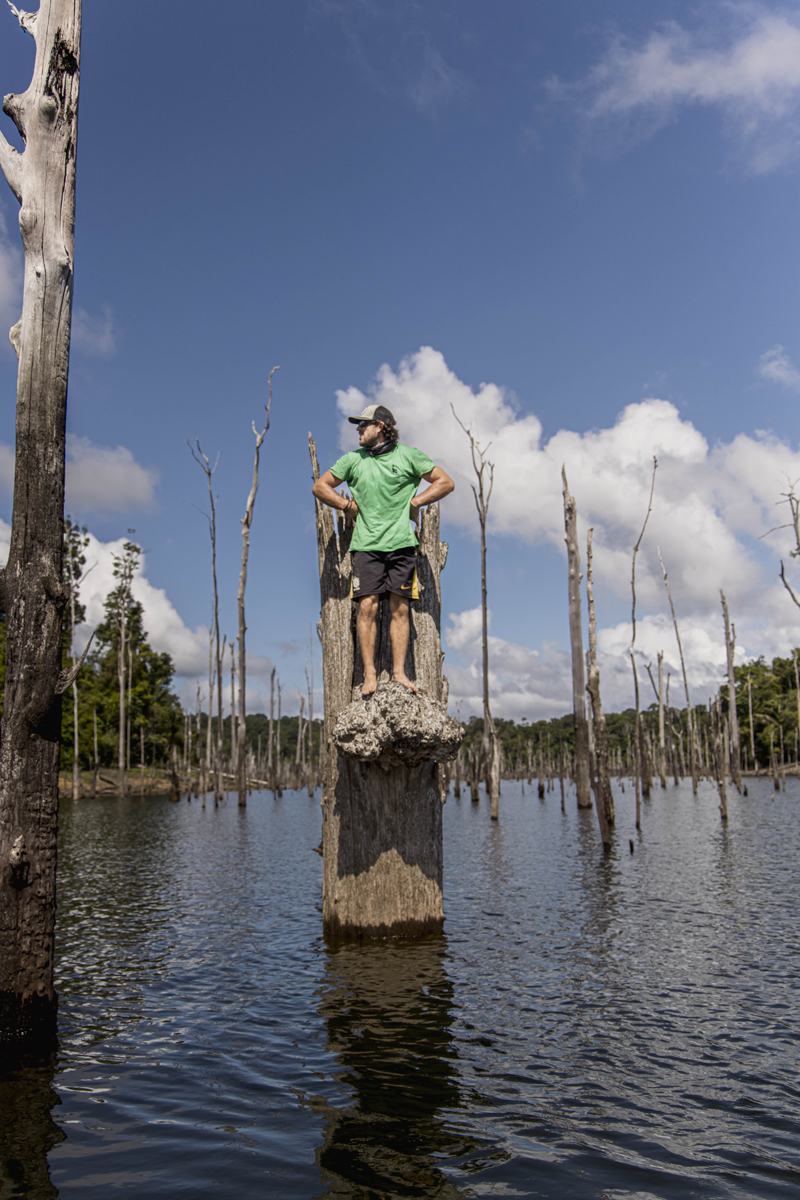
I take a slow breath and continue forward, scanning the river below, hoping to catch a glimpse of Yann’s red life jacket amid the chaos of granite boulders. And then, that feeling. That precise, primal sensation of heightened awareness. The beam of my headlamp sweeps over the narrow path, revealing a carpet of damp, brown leaves and twisted roots that make it impossible to move quickly. A creeping thought surfaces: What if…?
A flood of dark possibilities follows, scenarios with tragic outcomes. But I shake them off—now is not the time for distractions. Fear leads to hesitation, hesitation leads to mistakes. And mistakes, out here, could kill us. Focus. Stay alert. Keep moving. A few hundred meters further, something massive shifts beneath my feet—a black snake, thick as my wrist, slithering away before I can identify it. My heart pounds, but I press on. Then, another wild camp appears. Same drill. I stop. Listen. Nothing.
Cautiously, I step under the tattered tarps. The remnants of life are scattered around: old gasoline cans, empty bottles of cheap whisky, a splintered table with an ashtray perched on top. The scene is straight out of a horror movie.
“YANN!” I call out again, this time louder. A pause. Then - “YES!” Relief floods through me.
I quicken my pace, stepping into a clearing where the last shreds of daylight filter through the canopy. And then I see him—Yann, emerging from the jungle, soaked to the bone, grinning like a madman.
“Man! I climbed into the waterfall and watched a wolffish swim upstream like an Atlantic salmon!” he shouts, breathless with excitement. I laugh, exhaling the tension I hadn’t realized I was holding. He has no idea how much pressure had built up since I closed that damn book. A natural threshold in the river creates the perfect fishing spot, and within minutes, Yann hooks into something—a rare white Aimara. We stare, mesmerized by its pale coloration, its ghostly presence in the dark waters. Then comes the question: Do we eat it?
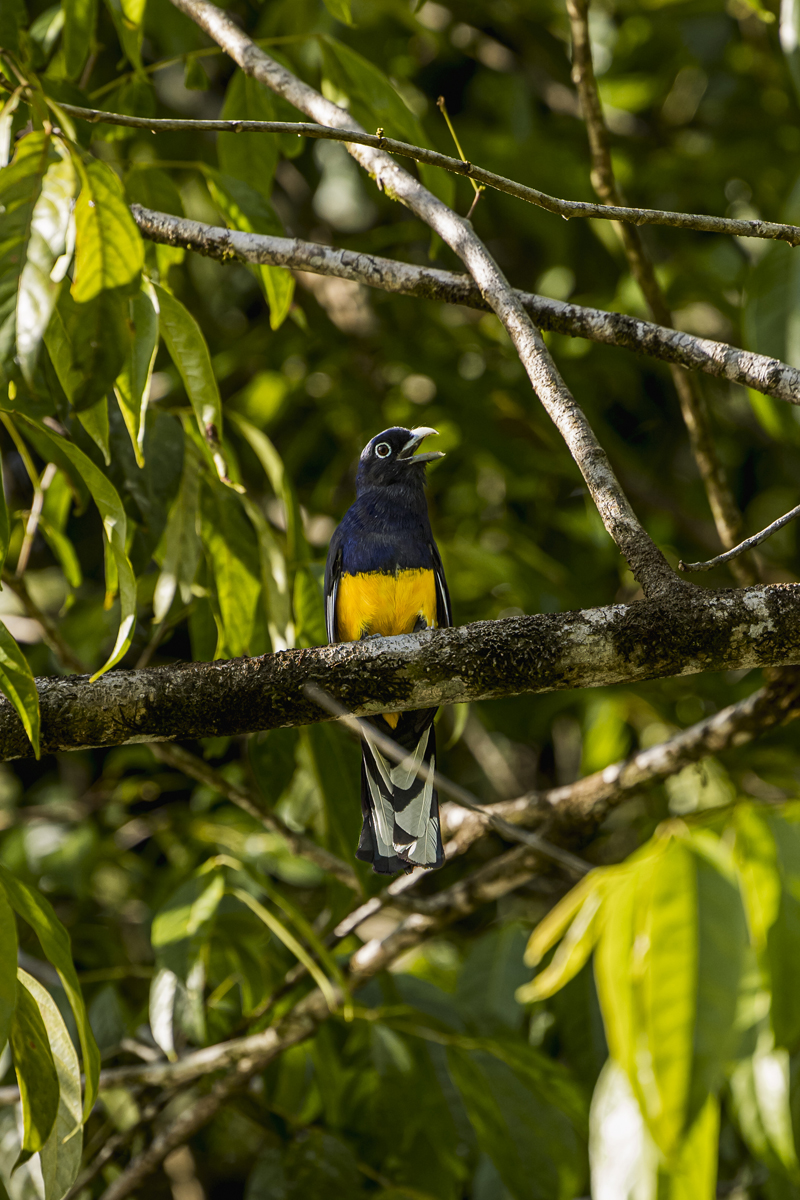
It’s a good six kilos—too much for one night, and by morning, it won’t be fresh. Letting it spoil would be a waste. With one last look, we release the Aimara back into the blackwater, watching it disappear into the depths. Time to head back.As we navigate fallen logs and tangled roots on the way to the canoe, I joke, “You did scare me a little back there.”
Yann grins. “Oh yeah, I know. Sorry… but it was too beautiful—I couldn’t stop.” I get it. I probably would’ve done the same.
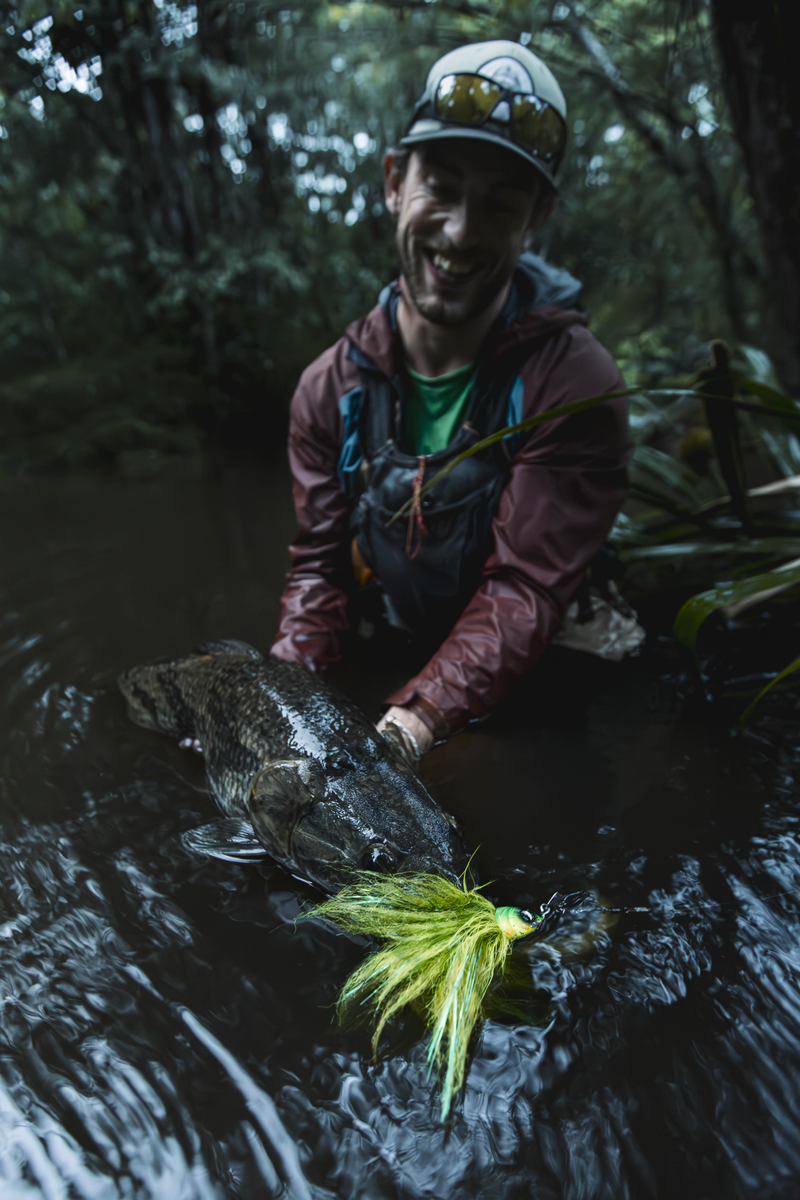
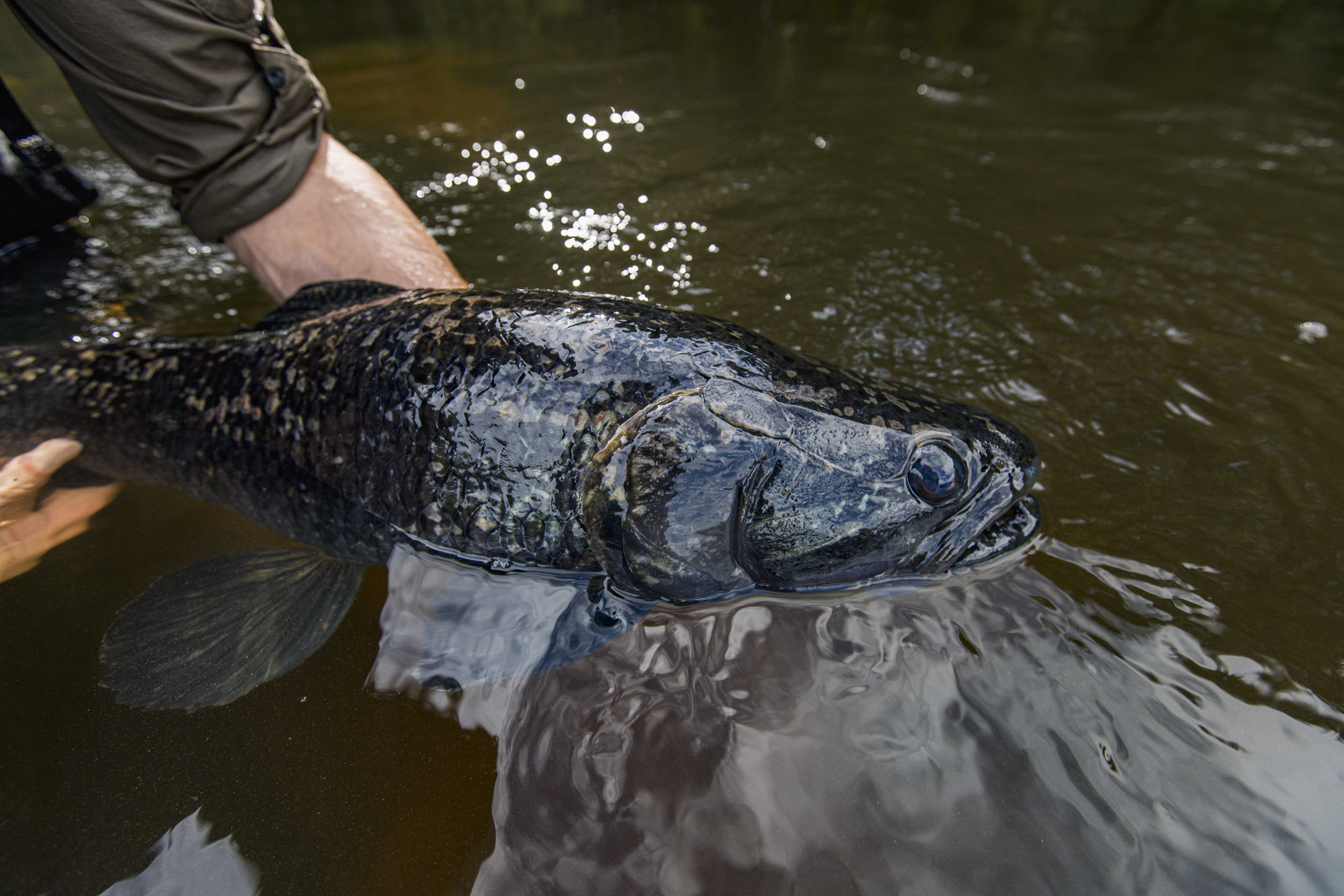
On the paddle back, we take the opportunity to gather the driest wood we can find for the fire. The journey is slow, retracing our route through the twisting tributary, then hauling ourselves a few hundred meters upriver to camp.
10:00 p.m. “Beer?” I ask. Bad joke. We’ve been drinking lukewarm river water for four days, and to make matters worse, our mosquito repellent leaked into the Katadyn filter— our only means of purifying water. The result? A nauseating cocktail of stale canteen water, lemongrass, and chemical repellent. Well, what’s for dinner?
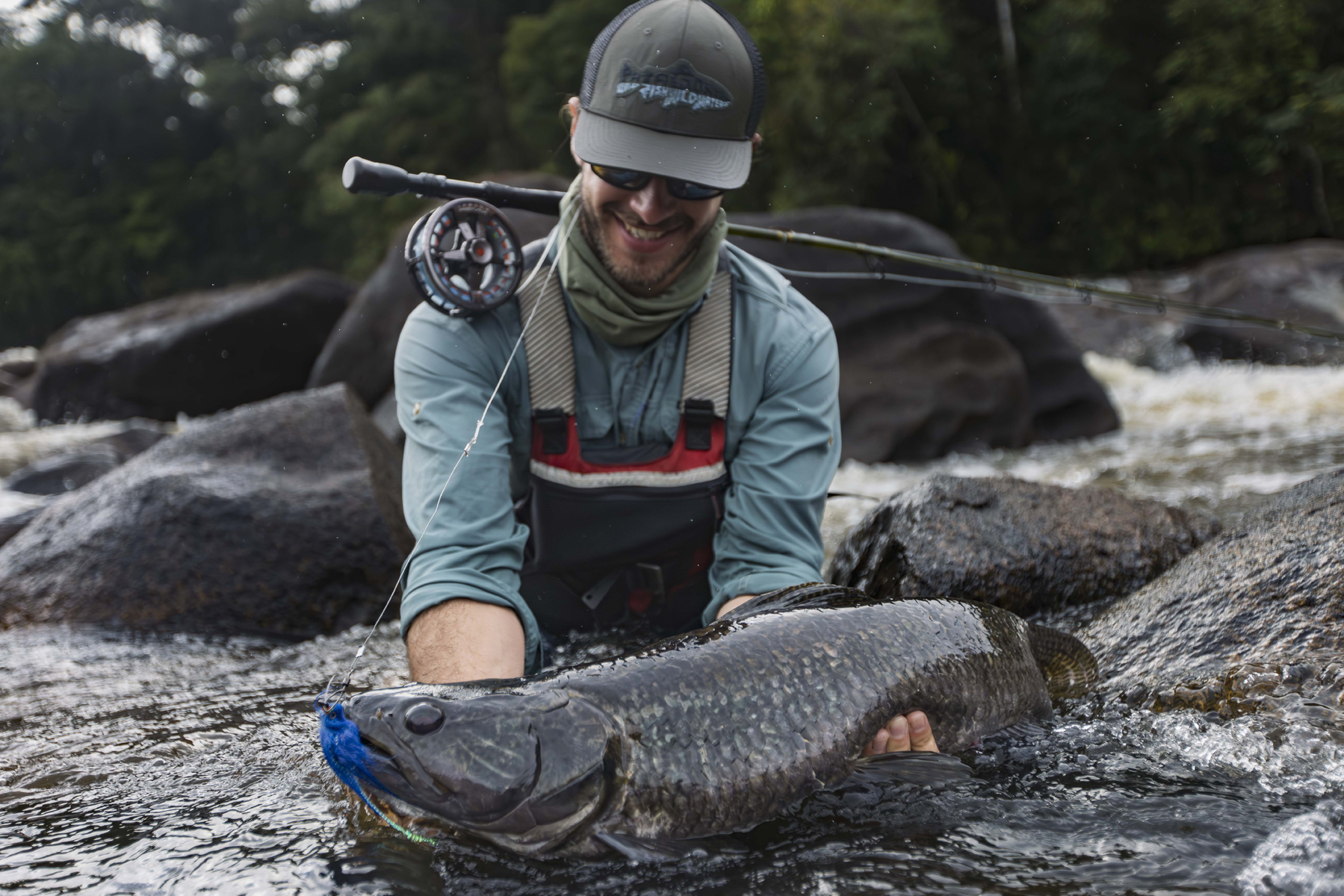
Fire, Feast, and Farewell
The plan had been to talk about cooking in the jungle—but first, we had to survive it.
To cook, we needed fire. And that’s not always easy in the heart of a tropical rainforest. But this time, we saw it coming—our stomachs had been protesting for too long to forget the essentials. Dry wood had been gathered along the way, and now it was time to put it to use.
Yann took charge of the fire. He crouched low, methodically feeding the flames, coaxing them to life. The scent of burning wood mingled with the damp, earthy air as I sliced peppers, catching glimpses of him between each careful cut. There was an unspoken rhythm to it, a natural balance between us. The perfect team.
The chicken was sliced into thin strips, the sweet potatoes into small cubes. The peppers, both mild and fiery, were cut into long, thin slivers.

A blend of salt, black pepper, and cayenne dusted the ingredients, followed by a drizzle of olive oil and a shake of cumin. Lime zest curled in fragrant shavings over the mixture, followed by the sharp burst of its juice. A final touch of honey softened the heat, and with that, the dish was left to marinate while we sipped on a wellearned Planteur—aged rum with ginger, brown sugar, and half a lime squeezed in for good measure. The cups clinked, a toast to the day’s adventure, the jungle crackling with unseen life around us.
When the wok hit the fire, the heat sent oil sputtering into flames, bursts of gold and orange dancing in the darkness. The aroma of searing spices filled the air, rich and heady. Flames illuminated the forest, flickering against the trunks of ancient trees. As the food browned, we raked the fire aside, creating a small bed of embers to let everything cook slowly.

Leaning against a tree, bowl in hand, the first bite was pure relief. The warmth of the dish, laced with lime and smoke, settled deep. Another sip of Planteur followed, the burn of the rum grounding us. Above, the Milky Way sprawled across the sky, untouched by the glow of any city, a vast and endless sea of stars. Another day came to an end.
The Long Road Back
With our provisions nearly exhausted, reality set in: it was time to leave. After ten and a half days, Mouchalagan was loaded with our remaining supplies and a few personal belongings. We pushed off from the shore, paddling away from the place that had, however briefly, become home. This time, we were in no rush.
Instead of following the most direct route back, we extended the journey by another forty kilometers, hugging the mainland, slipping into forgotten streams, exploring pockets of jungle that had likely not seen a human face in decades. The forest moved around us, alive in ways we could only witness from the edges. Scarlet macaws cut across the sky in flashes of red, while Atele monkeys launched themselves effortlessly through the canopy.
Capuchins observed us from a distance, their quick, darting eyes filled with mischief. Howler monkeys let out their guttural cries, shaking the air with each deep-throated roar. Heavy tapir tracks pressed into the mud reminded us that we were only visitors here.
And always, somewhere beyond our line of sight, there was the ultimate predator. The Jaguar. We knew he was there. Watching. Deciding. But he never revealed himself. Still, his silent presence was enough to remind us of where we stood in the hierarchy of this world.
Out here, there were no distractions, no noise, no endless notifications—just the forest, the river, and the rhythm of our own survival. No pollution. No signal. Only presence. The jungle set the pace, and, with quiet reverence, we followed.

